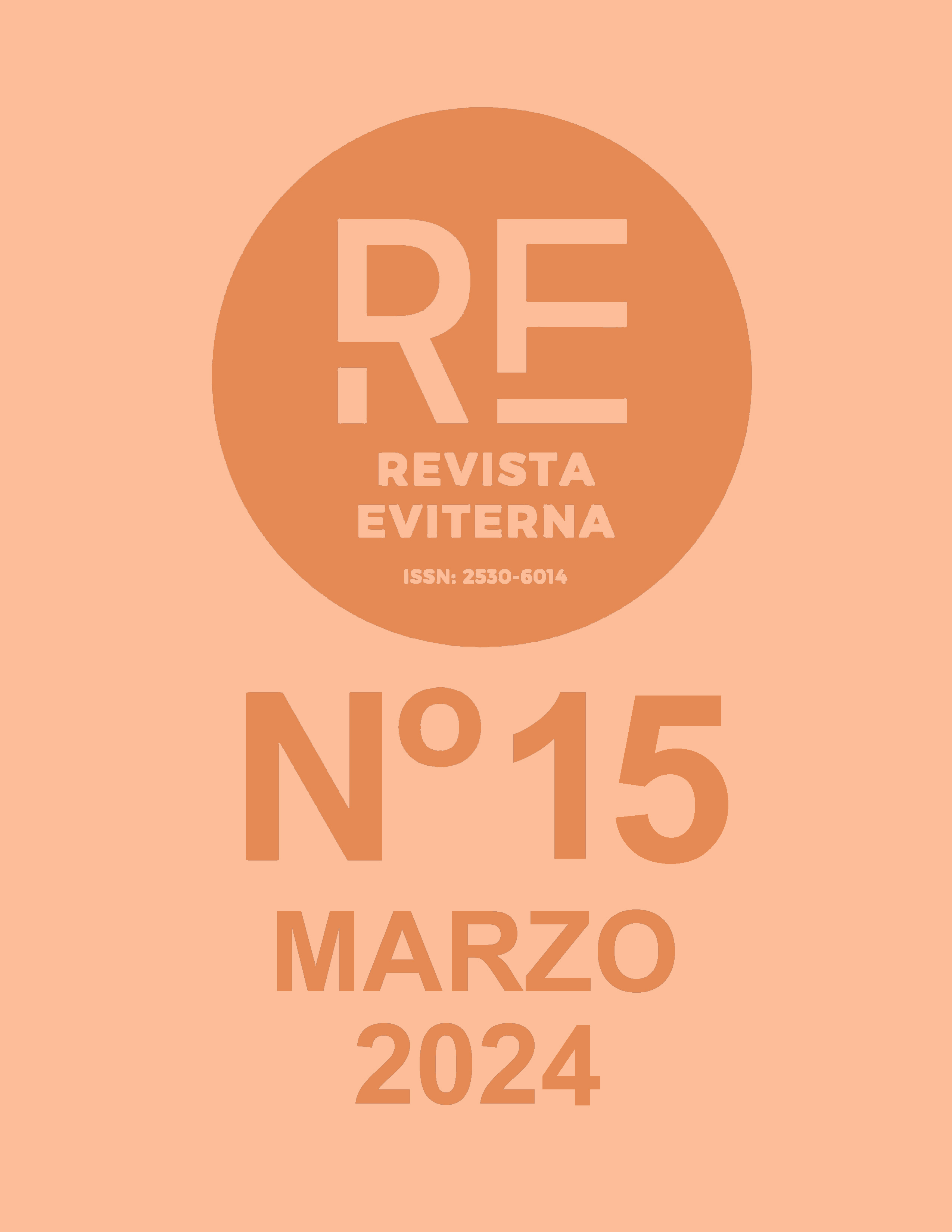El lenguaje del alma
Hilma Af Klint como pionera de la abstracción
DOI:
https://doi.org/10.24310/re.15.2024.18316Palabras clave:
Esoterismo, Espíritus, Mujeres artistas, Serie, TeosofíaResumen
A pesar de que durante su vida y parte del presente las obras de la pintora sueca Hilma af Klint (1862-1944) han pasado desapercibidas, en las últimas décadas su figura ha experimentado un resurgimiento, siendo objeto de exposiciones y estudios que la reconocen como pionera del arte abstracto. Se tratará su figura en aras de esclarecer por qué, a pesar de haber creado obras abstractas con anterioridad a 1910, no es la artista sueca la encargada de portar el título como pionera de la abstracción, recayendo este mérito en el pintor ruso Vasili Kandinsky (1866-1944). Su obra pictórica se gestó en las postrimerías del siglo XIX y principios del XX. Af Klint fue una artista que desafió las convenciones de su época fusionando el arte con la espiritualidad, por ello se analizará la importancia del esoterismo en su obra, así como la importancia de este en manifestaciones coetáneas y anteriores. Será de especial interés su relación y pertenencia al grupo espiritista de Las Cinco (De Fem). Durante su pertenencia a dicho grupo se le encargó la tarea de llevar a cabo su serie pictórica más conocida, las Pinturas para el Templo, colección que comprende más de 190 obras creadas a partir de 1906.
Descargas
Métricas
Publicación Facts
Perfil de revisores N/D
Información adicional autores
Indexado: {$indexList}
-
Indexado en
- Sociedad Académica/Grupo
- N/D
- Editora:
- Universidad de Málaga
Citas
Af Klint, E. et al. (enero de 1972). The Hilma af Klint Fundation. https://hilmaafklint.se/the-foundation/.
Althus, K. (2019). World Receivers: Georgiana Houghton – Hilma af Klint – Emma Kunz. Munich: Himer.
Bozal, V. (2003). Kandinsky origen de la abstracción. Madrid: Fundación Juan March.
Burgin, P. (2018). Hilma af Klint Notes and Methods. Chicago: The University of Chicago Press.
Castrillón, A. (2005). Kandinsky: Una mirada desde el presente. En Illapa Mana Tukukuq nº 2 (pp. 57-68) Recuperado de: https://revistas.urp.edu.pe/index.php/Illapa/article/view/1180/1074.
Clottes, J. y Lewis-Williams, D. (1996). Los chimanes de la prehistoria. Barcelona: Ariel.
Fant, Å. (1988). Hilma af Klint Hemliga Bilder = Hilma Af Klintin Salaisia Kuvia = Secret Pictures by Hilma af Klint. Helsinki: Nordiskt Konstcentrum.
Fant, Å. (1989). Hilma af Klint, Ocklur målarinna och abstract piojär. Estocolmo: Raster förlag.
Finch, E. (2005). Making Pictures Belong: Hilma af Klint Order of Trascendence. En Zegher, E. y Teicher, H. (eds.). 3 x Abstraction: New Methos of Drawing by Hilma af Klint, Emma Kunz and Agnes Martin (pp. 95-106). Nueva York: The Darwing Center.
Giedion, S. (1995). El presente eterno: Los comienzos del arte. Madrid: Alianza.
Gómez, I. (2019). Esoterismo y Arte Moderno. Una estética de lo irracional. Madrid: Akal.
Guirli, L. y Svensson A. M. (1999). Enheten bortom mångfalden. Två perspektiv på Hilma af Klint verk. Umeå: Rosengårdens förlag.
Harrison, C., Frascina, F. y Perry, G. (1998). Primitivismo, cubismo y abstracción. Madrid: Akal.
Henry, M. (2008). Ver lo invisible acerca de Kandinsky. Madrid: Siruela.
Irwin, R. (2008). Arte islámico. Madrid: Akal.
Kandinsky, V. (1989). De lo espiritual en el arte. México: Premia editora.
Kleveland, W. (2015). Den Stora Omvälvningrn. Myssteruets återkomst och monoteismen avväpning. Estocolmo: Kunska-pskonsult.
La Rubia de Prado, L. (2009). Nexos antropofilosóficos. La abstracción en el arte prehistórico y las vanguardias. En Gazeta de Antropología 25 nº 2 (pp. 1-28). Recuperado de: https://digibug.ugr.es/handle/10481/6915. DOI: 10.30827/Digibug.6915.
Malévich, K. (1924). Manifiesto del suprematismo. México: Universidad Nacional Autónoma de México.
Müller-Westermann, I. (2013). Cuadros para el futuro: Hilma af Klint, una pionera secreta de la abstracción, en Müller-Westermann, I. y Widoff, J. (eds), Hilma af Klint Pionera de la Abstracción (pp. 33-112). Estocolmo, Berlín, Málaga.
Navarrete, S. (2014). Abstracción y expresión: Una reflexión de base filosófica sobre los procesos de diseño. En Cuaderno del Centro de Estudios en Diseño y Comunicación (pp. 27-37). Recuperado de: https://dspace.palermo.edu/ojs/index.php/cdc/article/view/1701. DOI: https://doi.org/10.18682/cdc.v49i49.1701.
Pasi, M. (2014). Hilma af Klint, el esoterismo occidental y el problema de la creatividad artística moderna. En Boletín de Arte nº 35 (pp. 43-59). Recuperado de: https://revistas.uma.es/index.php/boletin-de-arte/article/view/3368. DOI: https://do.org/10.24310/BoLArte.2014.v0i35.3368.
Phillips, D. (1996). Abstraction and truth in nineteenth-century imagery. En Bulletinof the John Rylands Library (pp. 123-142). Recuperado de: https://www.escholar.manchester.ac.uk/api/datastream?publicationPid=uk-ac-man-scw:1m2159&datastreamId=POST-PEER-REVIEW-PUBLISHERS-DOCUMENT.PDF.
Rivera, M. P. (2015). El sentido numinoso de la luz. Aproximaciones entre creación y experiencia visionaria (tesis doctoral). Barcelona. Recuperado de: https://www.tesisenred.net/handle/10803/375898.
Surriugarte, I., Mediumnismo y arte. El caso de Hilma af Klint: de la mano dirigida a la mano intuitiva. En La Colmena nº 102 (pp. 85-103). Recuperado de: https://dialnet.unirioja.es/servlet/articulo?codigo=6998569.
Svensson, A.M. et al. (2005). Hilma af Klint: Greatness of Things. Dublín: Douglas Hyde Gallery.
Worringer, W. (1953). Abstracción y naturaleza. México: Fondo de Cultura Económica.
Publicado
Cómo citar
Número
Sección
Licencia
Derechos de autor 2024 Revista Eviterna

Esta obra está bajo una licencia internacional Creative Commons Atribución-NoComercial-CompartirIgual 4.0.
Todos los contenidos publicados en Revista Eviterna están sujetos a la licencia Creative Commons Reconocimento-NoComercia-Compartirigual 4.0 cuyo texto completo puede consultar en <http://creativecommons.org/licenses/by-nc-sa/4.0>

Se pueden copiar, usar, difundir, transmitir y exponer públicamente, siempre que:
- Se cite la autoría y la fuente original de su publicación (revista, editorial y URL de la obra).
- No se usen para fines comerciales.
- Se mencione la existencia y especificaciones de esta licencia de uso.
Los derechos de autor son de dos clases: derechos morales y derechos patrimoniales. Los derechos morales son prerrogativas perpetuas, irrenunciables, intransferibles, inalienables, inembargables e imprescriptibles.
De acuerdo con la legislación de derechos de autor, Revista Eviterna reconoce y respeta el derecho moral de los autores/as, así como la titularidad del derecho patrimonial, el cual será cedido a la Universidad de Málaga para su difusión en acceso abierto.
Los derechos patrimoniales, se refieren a los beneficios que se obtienen por el uso o divulgación de las obras. Revista Eviterna se publica en open access y queda autorizada en exclusiva para realizar u autorizar por cualquier medio el uso, distribución, divulgación, reproducción, adaptación, traducción o transformación de la obra.
Es responsabilidad de los autores/as obtener los permisos necesarios de las imágenes que están sujetas a derechos de autor.







12.png)



